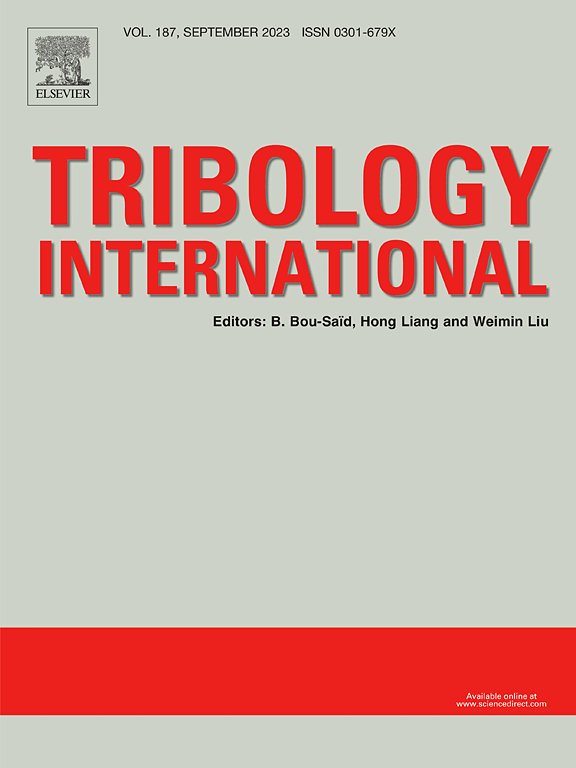Fretting wear mechanism of GH4169 dovetail joint specimens treated with hybrid laser shock peening
IF 6.1
1区 工程技术
Q1 ENGINEERING, MECHANICAL
引用次数: 0
Abstract
Aero engine blade structure is prone to severe fretting wear under centrifugal forces and vibration loads, resulting in greatly reduced engine service life, which is a typical fretting damage problem. In this paper, without Absorbing layer Nanosecond Laser Shock Peening (wAN-LSP) and without Absorbing layer Nanosecond superimposed Femtosecond hybrid Laser Shock Peening (NF-LSP) are utilized to strengthen the surface of GH4169 dovetail joint specimens, which is a common material for engine blades, to explore its strengthening mechanism and fretting wear evolution law. The findings indicate that the surface roughness of the wAN-LSP specimen rises from 0.28 μm to 1.16 μm. The thermal effects of wAN-LSP lead to the formation of a molten layer roughly 10.97 μm thick on the surface, accompanied by numerous pits, ablation holes, and micro-cracks. In contrast, NF-LSP treatment effectively eliminates the surface oxidation defects made by the thermal effects of wAN-LSP, leading to a slight decrease in surface roughness. Both wAN-LSP and NF-LSP treatments enhance the surface hardness of the specimens, creating a plastic deformation layer roughly 400 μm deep, but the near surface hardness of NF-LSP treated specimen is further improved compared to that of the wAN-LSP specimen. The wear mechanism observed in the GH4169 dovetail joint specimens following wAN-LSP and NF-LSP treatment are identified as abrasive wear and oxidation wear. Initially, as the number of cycles raises, the wear volume of GH4169 specimen treated with wAN-LSP is higher than that of untreated specimen, but subsequently, it becomes lesser than that of the untreated specimen. This phenomenon results from the interplay between the molten layer and hardened layer. In the initial stage of wear, despite the surface strengthening of the wAN-LSP specimen, the presence of molten layer significantly diminishes the fretting wear resistance of the material. As wear progresses, the molten layer is removed, revealing the benefits of surface strengthening. Throughout the wear process, the wear volume of NF-LSP specimen remains consistently lower than that of other two specimens. In comparison to the wAN-LSP treatment, NF-LSP treatment can enhance the surface condition of the material, leading to improve resistance of fretting wear across various wear stages.
混合激光冲击强化处理的GH4169燕尾接头微动磨损机理
航空发动机叶片结构在离心力和振动载荷作用下容易发生严重的微动磨损,导致发动机使用寿命大大降低,是典型的微动损伤问题。本文采用无吸收层纳秒激光冲击强化(wans - lsp)和无吸收层纳秒叠加飞秒混合激光冲击强化(NF-LSP)对发动机叶片常用材料GH4169榫尾接头试样表面进行强化,探讨其强化机理和微动磨损演化规律。结果表明,wAN-LSP试样的表面粗糙度从0.28 μm上升到1.16 μm;wAN-LSP的热效应导致表面形成约10.97 μm厚的熔融层,并伴有大量凹坑、烧蚀孔和微裂纹。相比之下,NF-LSP处理有效地消除了wAN-LSP热效应造成的表面氧化缺陷,导致表面粗糙度略有下降。wAN-LSP和NF-LSP处理均提高了试样的表面硬度,形成了约400 μm深的塑性变形层,但NF-LSP处理试样的近表面硬度比wAN-LSP处理试样进一步提高。经过wAN-LSP和NF-LSP处理的GH4169燕尾接头试样的磨损机制为磨粒磨损和氧化磨损。最初,随着循环次数的增加,经过wAN-LSP处理的GH4169试样的磨损体积大于未处理的试样,但随后逐渐小于未处理的试样。这种现象是熔融层和硬化层相互作用的结果。在磨损初期,尽管对wAN-LSP试样进行了表面强化,但熔融层的存在显著降低了材料的微动耐磨性。随着磨损的进行,熔融层被去除,显示出表面强化的好处。在整个磨损过程中,NF-LSP试样的磨损体积始终小于其他两种试样。与wAN-LSP处理相比,NF-LSP处理可以改善材料的表面状况,从而提高各个磨损阶段的抗微动磨损能力。
本文章由计算机程序翻译,如有差异,请以英文原文为准。
求助全文
约1分钟内获得全文
求助全文
来源期刊

Tribology International
工程技术-工程:机械
CiteScore
10.10
自引率
16.10%
发文量
627
审稿时长
35 days
期刊介绍:
Tribology is the science of rubbing surfaces and contributes to every facet of our everyday life, from live cell friction to engine lubrication and seismology. As such tribology is truly multidisciplinary and this extraordinary breadth of scientific interest is reflected in the scope of Tribology International.
Tribology International seeks to publish original research papers of the highest scientific quality to provide an archival resource for scientists from all backgrounds. Written contributions are invited reporting experimental and modelling studies both in established areas of tribology and emerging fields. Scientific topics include the physics or chemistry of tribo-surfaces, bio-tribology, surface engineering and materials, contact mechanics, nano-tribology, lubricants and hydrodynamic lubrication.
 求助内容:
求助内容: 应助结果提醒方式:
应助结果提醒方式:


